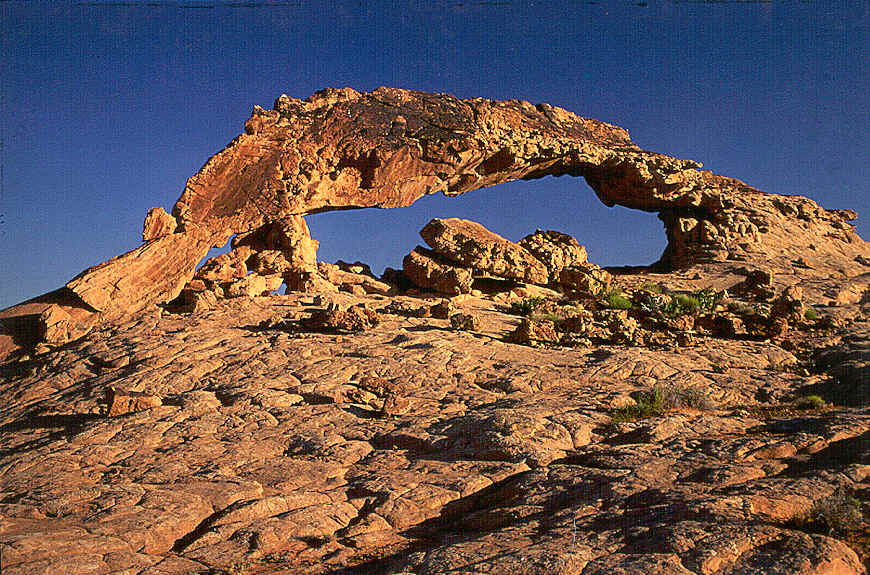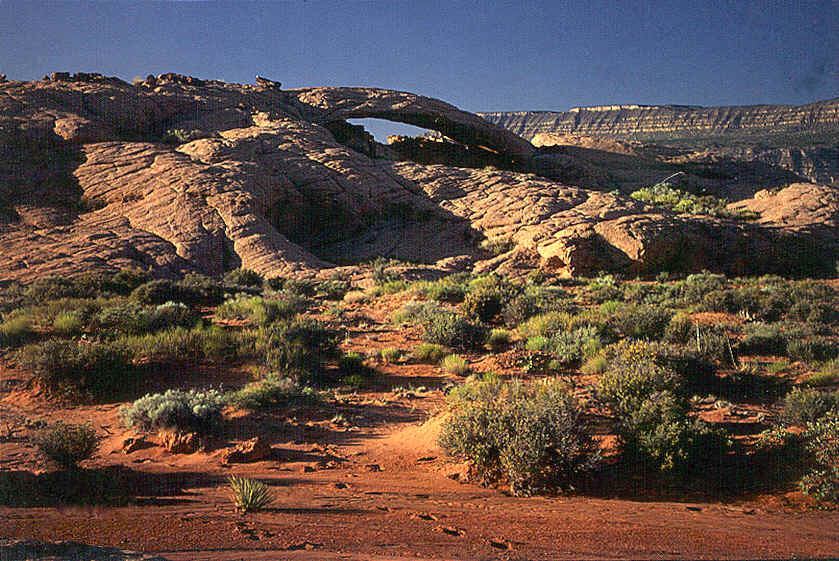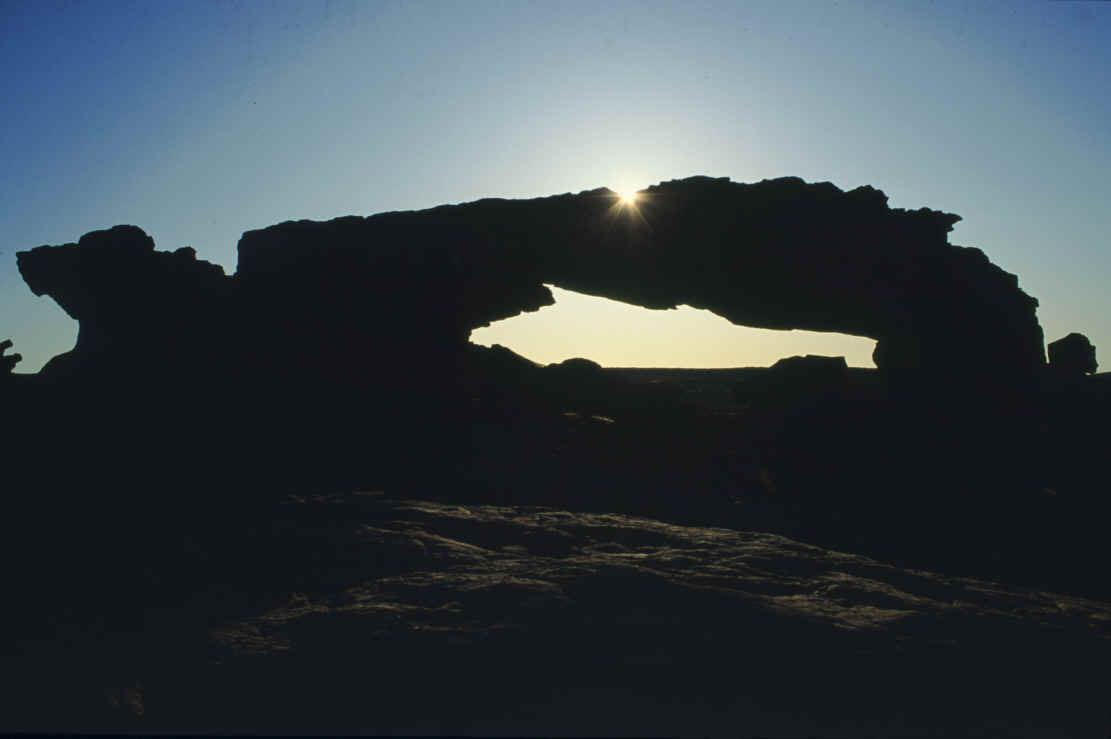

I had already had one goose chase that day, Tuesday, May 2, 1995 -- the Broken Bow Arch simply wasn't where it was supposed to be, and I didn't want to start the major trek down to the Jacob Hamblin Arch yet, since it's only good in the morning light for photography. So I decided to maybe salvage the day by looking for the Sunset Arch. I didn't have any directions with me, but I remembered the guidebook said you can see the arch to the south of the water tank on the 40-mile Ridge Road, which is really only 32 miles down the Hole-in-the-Rock Road, a 60-mile-long dead-end dirt road to nowhere in the Utah desert, which is part of the Escalante National Monument now but wasn't then. Well, maybe you can see it, but the arch guide I had is notoriously bad on directions, so for all I could tell it was probably edge-on and totally indistinguishable from every other lump of rock to the south, of which there were plenty. But there was one area that seemed to have a lot more lumps of rock than anywhere else, so I decided that would be the place to try, so off I went.
Sunset Arch -- Escalante National Monument, Utah:

It seemed to be a mile and a half or
two miles away to that area, but I've learned long ago that what looks like a
mile hiking is probably two or three actually, because of all the ridges and
gullies, rocks and puddles, sagebrush bushes and cactuses to dodge, and in this
case, cowpiles too. It was basically all downhill, which meant coming back would
be a drag, but I was bouncing along quite happily for the moment, till I jumped
down into a wash and nearly tripped right over a rotting cow carcass. She hadn't
been dead very long, either -- I had seen bleached bones here and there on the
desert often enough, but this cow had a long ways to go before she got to that
stage. It's kind of hard to hold your breath when you're already out of it, and
trying to move on out pretty fast besides. On downwind, I soon noticed a group
of cattle to the left, but didn't think much of them until I realized there was
a large bull in the group who now had interest in me. We both eyed each other
warily, while I tried to form plans for an emergency, and decided the only thing
to do in such a case would be to learn to be a matador real quick. On this open
plain without a tree or fence in sight, I could be in real trouble, if he
decided to make some, and it was still a long way to the rocks. But he behaved
and I moved on through.
Eventually, I reached the rocks, and wandered past all sorts of formations --
lumps and piles and towers and potholes, but no sign of an arch. It was also
getting late, which was one reason I was out here, because I hoped to get good
pictures of the sunset through the arch -- it's one of the rare completely
free-standing arches, where you can get a good picture from either side, with no
cliffs around to block the evening sun. But after a fast tour around the whole
area, I gave up, it wasn't there. I wondered then if it was really in a ridge I
had seen way off to the east as I hiked out to where I was. I decided to swing
off that way on the way back, though it would put me a long way from the truck,
but I didn't need another goose chase, a wasted hike. On the way there, I looked
far off to the west, and saw a formation sort of by itself that I hadn't noticed
before.
I'm always imagining I've got somebody with me to talk to on these lonely hikes,
so my friend, Gary, spoke up and said, "It looks like there's a hole in
that rock." I didn't think so; it looked like one to me too, but it was so
big and obvious that I didn't think I could have missed it on the way out, and I had
passed it a lot closer then. "I can see right thought it, it's green like
the field behind it," he said. I told him, "No, that's just a green
bush in front of the rock, I've been fooled like that a lot of times."
"It sure looks like an arch to me," he kept saying, and I kept trying
to convince him of my superior rock-country knowledge by assuring him it was
just an illusion. We kept trudging on, and gained a little ground. He looked
over again, and announced, "See, it's not green through there anymore, it
looks brown, like the ridge below it!" So then I began to think maybe he
had better eyes than I do (he does), and it did look like it had changed color
through what could have been an opening, so "we" took off in that
direction to get a real look. It was too late now to go all the way, and even if
that really was the arch, I wouldn't have had time for pictures; the sun was
already going down. But the closer I got, the more it looked like the picture I
had seen, and soon there was no doubt. I would have to come back tomorrow, not
for the sunset, but for the sunrise.
I starting really trucking, now, back to the truck. It was pretty late, and
getting dark quick. I hoped the cows were gone, I couldn't see them, but I could
hear the bulls bellowing occasionally. I couldn't see the truck, or tell if I
was heading exactly to where I was parked or not, after all the zigzagging I had
done, but I was real glad after a while when I ran across a track of footprints.
I stamped my foot in the sand next to them -- yep, same pattern; so I started
stepping in my own tracks, making weird-looking "X"-shaped prints
where they crossed, since my feet don't ever point straight ahead while walking,
but sideways like a duck. Following your own prints uphill step for step takes a
lot more effort that a normal uphill stride would take, since they were
originally made with a wide downhill lope, but I was in a hurry now trying to
get out before total darkness, and trying to spot each print of my crooked trail
one instant before I put my foot in it. I was concentrating so on my every step,
that I almost fell right onto the icky dead cow again, and promptly lost the
trail while running away from her. It showed up later, and before long, there I was,
safe and sound in the truck.
I set up the tent in the truckbed, for bull protection, and woke up
quite annoyed that the sun had already risen. Well, my pictures would just have
to be daylight pictures. I decided to take a different route this morning, since
I knew where I was going this time, one that wouldn't have such an incline and
no bulls in sight. I took off, and in twenty minutes, I was there! It was really
quite an ugly arch -- I had already thought so just from the picture I had seen;
but it is an interesting one since it seems to have no reason for existence.
It's not part of a cliffside that collapsed, or a cave that caved in, or a
pothole that wore through, or any of the usual arch formations -- it's just an
ugly black and orange span of rock all by itself on a desert plain, and it may
not be there for long, either. The west end is severely precarious, and twisted
off center. The main weight of the arch on the west end is not even on the place
where it comes down to the ground, but on a big boulder wedged under it near the
end. But naturally, in spite of its fragility, I had to climb under, through,
on, and over it. I got some good pictures (I hoped), but the best was yet to
come!
A hundred yards to the south, there was another arch, and bigger than this one!
Prettier, too! What were the odds of that? They weren't even made out of the
same kind of rock, but here they were, almost side by side, on this barren
plain! It turned out to the one of the few places I've ever seen where you can
see (and photograph) one arch directly through another.
Moonrise Arch

The second arch, which I found out later someone appropriately had named
Moonrise Arch, was
longer than the Sunset Arch, but a lot more clogged up with boulders directly
under it. You could hardly stand upright while passing through it, because
of all the rocks. I decided to do a
bit of creative arch improvement, by pushing out what rocks I could. That might
well be frowned on by other arch hunters, but this one was so little-known and
remote that a little bit of helping nature seemed okay to me. I hoped that the
crashing of boulders into the dry wash below wouldn't bring the whole arch
crashing right down on my head, which I guess would have been my just reward for
destroying a national monument. As I was pitching rocks, I picked up one large
one, and let out quite a squawk. Right under it was a coiled-up rattlesnake.
In
all my many years of desert hikes, I'd never seen a single snake before, but
maybe that was because I usually didn't go around tearing the roof off their
homes. He just sat there, sticking his tongue out at me, hardly moving.
I
decided, since he had scared me, I might as well annoy him too, so I tossed a
few pebbles on him to hear him rattle. (I figured that was educational -- it
could be useful to learn to recognize that sound, and it was -- I've heard it
since.) He started rattling all
right, and then he wouldn't shut up. But I had decided I was through with this
arch, and it was time to go.
Not may people have ever visited this place, but on the way back though the
Sunset Arch, I found some "historical graffiti" beneath the span.
Carving a name or defacing a feature on National Park land is a criminal offense
now, as it should be; but old carvings can be interesting and have actually been
helpful in tracing the trail of famous early explorers. The name "Till
Woolsey, 1924" had been carved very painstakingly and quite beautifully
on the wall of the arch, and nearby, in a more exposed area, was "Wells
W……." -- illegible. Till's brother? Explorers?
Cowboys? Mormon pioneers? They are probably long gone now, but the arches they found still
glow in the sunset and greet the moonrise on a desert plain in Utah.
* * * * * * * * * * * *
